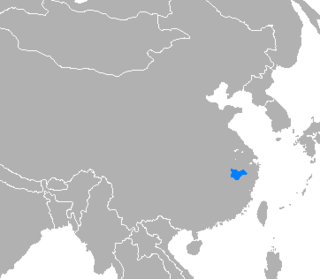
Huizhou or Hui, is a group of closely related varieties of Chinese spoken over a small area in and around the historical region of Huizhou, in about ten or so mountainous counties in southern Anhui, plus a few more in neighbouring Zhejiang and Jiangxi.
The history of the administrative divisions of the Imperial China is quite complex. Across history, what is called 'China' has taken many shapes, and many political organizations. For various reasons, both the borders and names of political divisions have changed—sometimes to follow topography, sometimes to weaken former states by dividing them, and sometimes to realize a philosophical or historical ideal. For recent times, the number of recorded tiny changes is quite large; by contrast, the lack of clear, trustworthy data for ancient times forces historians and geographers to draw approximate borders for respective divisions. But thanks to imperial records and geographic descriptions, political divisions may often be redrawn with some precision. Natural changes, such as changes in a river's course, or loss of data, still make this issue difficult for ancient times.

Jining is a prefecture-level city in southwestern Shandong province. It borders Heze to the southwest, Zaozhuang to the southeast, Tai'an to the northeast, and the provinces of Henan and Jiangsu to the northwest and south respectively. Jining, which is located directly to the north of Lake Nanyang, is today the northernmost city reachable by navigation on the Grand Canal of China making it an important inland port.

She County, or Shexian, is a county in the southeast of Anhui Province, China, bordering Zhejiang Province to the east. It is the easternmost county-level division of the prefecture-level city of Huangshan City. It has a population of 500,000 and an area of 2,236 square kilometres (863 sq mi).
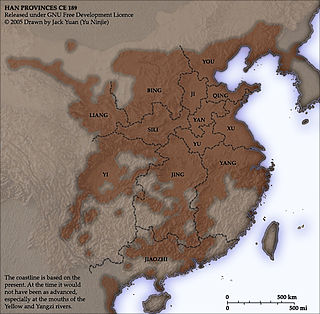
You Prefecture or Province, also known by its Chinese name Youzhou, was a prefecture (zhou) in northern China during its imperial era.
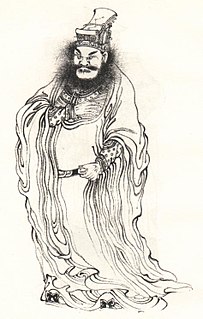
Hu Dahai, courtesy name Tongfu (通甫), was a Chinese military general who lived in the 14th century. He is best known for helping Zhu Yuanzhang establish the Ming dynasty in China.

Yanzhou is a district and former county-level city under the prefecture-level city of Jining, in the southwest of Shandong province, People's Republic of China.It was also one of the Nine Provinces in ancient China,where Yu combated floods by water control.

Wang Yi ; ca. (1333-unknown) was a Chinese painter of human figures during the Yuan Dynasty (1271–1368). His specific date of death is unknown.
Jinxiang dialect (金鄉話), is a Taihu Wu dialect, or a Northern Wu dialect, spoken in Cangnan county of Wenzhou prefecture-level city. It is considered to be a Taihu Wu linguistic exclave within the mostly Min Nan-speaking part of Southern Zhejiang.
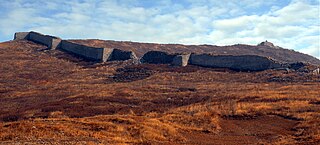
Yanzhou Village is a small settlement in Dengta Prefecture of Liaoyang Prefecture in Liaoning Province in China. The village is the site of the ancient Goguryeo city of Baegam in Korea or Baiyan City in Chinese. The ancient city was the scene a major battle between the Tang dynasty Chinese emperor Taizong and the Goguryeo in 645 AD.
Yanzhou Prefecture was an administrative unit (prefecture) in Zhejiang Province of China during the Ming and Qing Dynasties. It was abolished in 1912, soon after the fall of the Qing. The territory of the former Yanzhou Prefecture is now part of the Hangzhou Prefecture-level city.
Yangzhou, Yangchow or Yang Province was one of the Nine Provinces of ancient China mentioned in historical texts such as the Tribute of Yu, Erya and Rites of Zhou.

Yanzhou or Yan Prefecture was a zhou (prefecture) in imperial China centering on modern Yanzhou District, Jining, Shandong, China. It existed (intermittently) until 1385, when the Ming dynasty created Yanzhou Prefecture.

Xiuzhou or Xiu Prefecture was a zhou (prefecture) in imperial China, centering on modern Jiaxing, Zhejiang, China. Its administrative area contained most of modern Shanghai. It was created by the Wuyue kingdom in 938; in 1195, the Song dynasty renamed it Jiaxing Prefecture.

Liangzhe Circuit (997–1160s) was one of the major circuits during the Song dynasty (960–1279). Its administrative area corresponds roughly to modern Zhejiang, Shanghai, and southern Jiangsu. The fertile Yangtze River Delta lay within Liangzhe Circuit, as did Lake Tai. Liangzhe was the wealthiest circuit in Song.
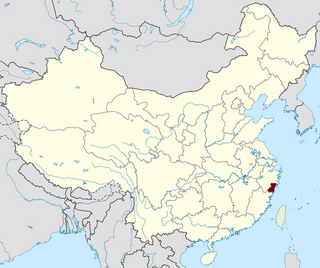
Wenzhou or Wen Prefecture was a zhou (prefecture) in imperial China, centering on modern Wenzhou, Zhejiang, China. It existed (intermittently) from 675 to 1265, when the Song dynasty renamed it Rui'an Prefecture.
Huzhou or Hu Prefecture (湖州) was a zhou (prefecture) in imperial China, centering on modern Huzhou, Zhejiang, China. It existed (intermittently) from 602 until 1912. Between 1225 and 1276 it was known as Anji Prefecture (安吉州).
















